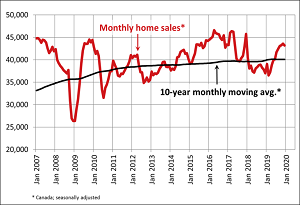 Thursday, April 25, 2024
Thursday, April 25, 2024  Thursday, April 25, 2024
Thursday, April 25, 2024 
The Canadian Real Estate Association reports that national home sales eased between November and December 2019.
Highlights:
Home sales recorded over Canadian MLS® Systems edged down 0.9% in December 2019, ending a streak of monthly gains that began last March. Activity is currently about 18% above the six-year low reached in February 2019 but ends the year about 7% below the heights recorded in 2016 and 2017.
There was an almost even split between the number of local markets where activity rose and those where it declined, with higher sales in the Lower Mainland of British Columbia, Calgary and Montreal offsetting declines in the Greater Toronto Area (GTA) and Ottawa.
Actual (not seasonally adjusted) activity was up 22.7% compared to a quiet month of December in 2018. Transactions surpassed year-ago levels across most of Canada, including all of the largest urban markets.
“Home price growth is picking up in housing markets where listings are in short supply,” said Jason Stephen, president of CREA. “Meanwhile, the mortgage stress-test continues to sideline potential home buyers where supply is ample. All real estate is local, and nobody knows that better than a professional REALTOR®, your best source for information and guidance when negotiating the sale or purchase of a home,” said Stephen.
“The momentum for home price gains picked up as last year came to a close,” said Gregory Klump, CREA’s Chief Economist. “If the recent past is prelude, then price trends in British Columbia, the GTA, Ottawa and Montreal look set to lift the national result this year, despite the continuation of a weak pricing environment among housing markets across the Prairie region.”
The number of newly listed homes slid a further 1.8% in December, leaving new supply close to its lowest level in a decade. December’s decline was driven mainly by fewer new listings in the GTA and Ottawa–the same markets most responsible for the decline in sales. Listings available for purchase are now running at a 12-year low. The number of housing markets with a shortage of listings is on the rise; should current trends persist, fewer available listings will likely increasingly weigh on sales activity.
With new listings having declined by more than sales, the national sales-to-new listings ratio further tightened to 66.9% in December 2019 – the highest reading since the spring of 2004. The long-term average for this measure of housing market balance is 53.7%. Barring an unforeseen change in recent trends for the balance between the supply and demand for homes, price gains appear poised to accelerate in 2020.
Considering the degree and duration to which market balance readings are above or below their long-term averages is the best way of gauging whether local housing market conditions favour buyers or sellers. Market balance measures that are within one standard deviation of their long-term average are generally consistent with balanced market conditions.
Deadline for this week in Friday at noon